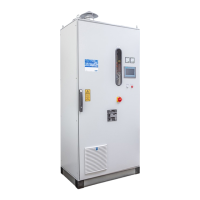EN
7
4 Function
Ozone is a colourless gas with a characteristic odour. Chemically, ozone,
or O
3
, consists of three oxygen atoms and can be produced from the oxy-
gen, or O
2
, in the air. A relatively high concentration of ozone is required
foreectivedisinfectionofpoolwaterandoxidationofunwantedwater
contaminants. When air is used as feed gas such high concentrations
can only be obtained if the air is dried prior to ozone generation.
4.1 Air drying
The unit contains two dryers that work alternately. Each dryer contains a
specialmixtureoftwodesiccantsinamulti-layeredlling.Thedesiccant
extracts moisture from the passing air by adsorption, so that the dewing
point of the air on leaving the dryer is lowered to under –50°C.
The desiccant has limited water absorption capacity, and must be
regenerated when the capacity is exhausted. The unit regenerates the
desiccantautomatically.Inaddition,aregenerationairowisheatedin
a heating register and fed through the dryer in the opposite direction.
The air is heated until the temperature at the regeneration air inlet of
the dryer has reached 220°C. The temperature of the regeneration air
is maintained at this value using a thermostat. Hot air is fed through the
dryer until the temperature at its regeneration air outlet has reached
140°C; this ends the regeneration heating time. The unit displays the
warm-up time and heating time. The dryer then cools down. Once it
reaches room temperature again, regeneration is complete. While one
dryer is being regenerated, the unit can be operated using the other dryer.
Thecycletimeofadryeriscalculatedfromtheairowthatitdriesand
the maximum moisture content of this air. The operator can set both of
these values on the TP (touch panel).
The ozone is generated and conveyed using vacuum. The air is drawn
through the unit by an external suction pump. The suction pump can be
an injector driven by a booster pump.
TheunitsaredesignedasunderpressureunitsasdenedbyDIN19627.
In underpressure units, the gas used/ozone in the whole gas compart-
ment up to the ozone/water mixing device is under lower pressure
than the air in the surrounding installation area. It is therefore physically
impossiblefortheozonetoowoutfromthegascompartmentintothe
installation area air.
4.2 Ozone generation
Four operating modes are provided for switching ozone generation on/
o.Panel,ext.contact,ext.+P/PID,databus:
1. Panel: manually on the device
2. Ext. contact: The unit is switched on using an external customer-
suppliedoatingcontact
3.Ext.+P/PID(P/PIDcontrolleroption):Theunitisswitchedoninthe
same way as point 2 if ozone is also requested simultaneously using
the P/PID controller signal.
4.Databus(Pronet/Probusoption):Activationissetexternallyusing
the data bus. The available data bus connections are:
a)Pronetwithdataexchangeusing“Put/Get”commands
b)Pronetwiththeintegrationoftheozonedeviceintothecustomer
controlsystemusinga“GSD”le
c)ProbusDPwiththeintegrationoftheozonedeviceintothecustomer
controlsystemusinga“GSD”le
In addition to the activation signal, the release for ozone generation must
be set on the panel. The unit starts up when the release and activation
signal are provided.
If ozone generation activated, there is a purge phase with air beforehand.
The pre-operation purge removes any remnants of moist air from the
ozone tubes.
To generate ozone, dry air is fed to a discharge gap in the ozone tube.
A high voltage discharge is ignited across this discharge gap. The ozone
is formed from the oxygen in the air within the corona plasma created
during this process: 3 O
2
→ 2 O
3
.
3 Use
3.1 Intended Use
BWT Bewazon VULW 12 to 700-series ozone devices produce ozone
by means of corona discharge and comply with the requirements of the
standard DIN 19627.
Ozone is ideally suited for the oxidation of unwanted contaminants in wa-
ter and the disinfection of water, especially pool water (see DIN 19643).
Bewazon VULW 12-700-type systems are designed in compliance with
the following standards for industrial applications:
– DIN EN 61000-6-2.
– DIN EN 61000-6-4.
3.2 Foreseeable misuse
● Any use other than the use described under point 3.1.
● Not adhering to the prescribed process parameters and mainte-
nance and service intervals.
● Unauthorisedalterationormodicationofpartsoftheunit.
● The use of unauthorised spare parts.
3.3 Disclaimer
The manufacturer is released from any liability if the customer intenti-
onally or forcibly removes or circumvents guards or safety devices, if
the customer uses unauthorised spare or wear parts, or if the customer
does not follow the instructions in this operating manual or on the unit.

